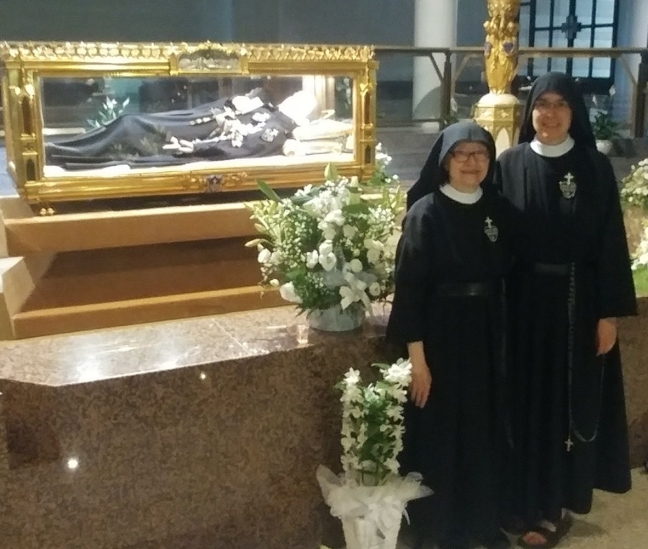Passionist Holy Places
Mother John Mary and Sister Catherine Marie were recently in Rome for a week of meetings about strengthening communion between the Passionist Nuns throughout the world, and they took advantage of their time in the “Eternal City” to visit some of the holy sites of our Passionist history. Here are a few pictures and stories from their pilgrim adventures, adapted from their delightful diary of the travels.
On one of their first days in Rome, they visited the Church of Santa Maria in Domnica, also called the Navicella because of the boat-shaped fountain in front of the church entrance. This church is just down the street from SS. John and Paul, the generalate of the male Passionists where Mother and Sister stayed. This fountain marks the place where our holy founder, St. Paul of the Cross, and his brother, Ven. John Baptist Danei received the Pope’s verbal permission to start gathering companions.
One day, our friend and community canonist Msgr. Michael Palud, CO, offered holy Mass at the tomb of St. Paul of the Cross in his side chapel in the Basilica of SS. John and Paul. Then they took a tour of the basilica.
Another day, they drove to Monte Argentario to visit the first Passionist Retreat – dedicated to the Presentation of Mary – and St. Joseph’s Novitiate, a bit further up the mountain. Here they are on the drive up, with the Presentation Retreat in the background!
At the Retreat of the Presentation, they saw a 300-year old+ tree under which our holy founder had prayed when he and Fr. John Baptist first lived on the site. It was already a tall tree when Paul prayed there in the 1730’s and 1740’s. There was an air of holiness surrounding this prayer nook, and our pilgrim nuns stayed awhile there.
A couple of days later, they were blessed to travel to the Apennines to see the shrine of St. Gabriel of Our Lady of Sorrows (Possenti). They had Mass in the room in which St. Gabriel died. It had been the room of his spiritual director, Fr. Norbert, which the priest gave up so that Gabriel would be more comfortable as he lay dying.
At St. Gabriel’s time, the bodies of the Passionists were buried one on top of another under the floor of the basilica. Fr. Norbert had the inkling that St. Gabriel’s remains should be marked in some way, so he placed a crown of flowers on his body which identified the saint when he was exhumed for the process of his beatification. That wreath of flowers has been preserved, as has the leather belt he wore around his habit.
This is the original shrine of St. Gabriel, an ancient monastery, founded by St. Francis of Assisi, which was given to the Passionists three years before Gabriel arrived and they had to flee from it three years after he died. With such a narrow window of Passionist residence during Gabriel’s lifetime, it really seems that God wanted Gabriel's shrine to be in this place! The people of the Abruzzi region, where St. Gabriel’s shrine is, have an uncanny ability to recognize sanctity. Even while he was alive they knew he was a saint. They would come to Mass just to see him go to Holy Communion.
Finally, here are Mother John Mary and Sr. Catherine Marie inside the new shrine of St. Gabriel, beside the lifelike reliquary of our holy brother in the Passion. You can see more photos of the shrine here.
What a blessing to walk in these places trod by so many saintly followers of Christ Crucified!
P.S. Although San Clemente is not a Passionist Holy Site, surely our Founder prayed there since it is just down the hill from Ss. John and Paul. While in Rome we had a delightful visit with our fellow-Kentuckian, Fr. Austin Litke, who gave us a tour of the ancient basilica and the excavations beneath the present basilica.








